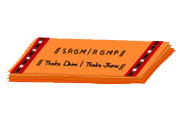Posted By: Administrator
Rāga:
Hamsadhwani
Thāḷa:
Khanḍa Chāpu
Composer:
Gaṅgai Mutthu Naṭṭuvanār
Language:
Thamizh (Tamil)
Meanings – Word by word
& Overall:
Alignment, Diacriticals
& consequent spelling changes, Language & grammar editing, if any and
necessary, of existing meaning: Team Ambalam
Viruttham
/ Śhlokam
Yārukkum
adaṅgādha nīli ponnambalathil āḍināḷ kāḷi
Pāruḷ
parabrahmatthai aḍakkiya chayai pāḍum védhaṅgaḷālum ariyādha māyai||
Kauthvam
Tha dhīm
thaka dhīm thadhīm thadhīm
Thakkiṇam
tharikiṭa thaka thakiṭa tham tham
dhikkinam
dhimikiṭa dhīmdhīmku nam nam
Thakkiṇam
tharikiṭa thaka thakiṭa tham tham
dhikkinam
dhimikita dhīmdhīmku nam nam
thakathakiṭa
tham dhriguthakiṭa dhīm –
thaka
thakiṭa dhrigithakiṭa thomdhruthakiṭa nāmdhruthakiṭa
Thakkudhikkiṭathaka
thaka thakiṭa tham tham
dhikkudhikkiṭathaka
ḍhīṇ ḍhīṇku nam nam
thakathakiṭa
tham dhriguthakiṭa dhīm –
thaka
thakiṭa dhriguthakiṭa thomdhruthakiṭa namdhruthakiṭa
Thakkudhikkiṭathaka
thaka thakiṭa tham tham
dhikkudhikkitathaka
ḍhīṇ ḍhīṇku nam nam
thakathakiṭa
dhriguthakiṭa thomkina thoṇakina
thothoku
thokiḍa thillaiyālankāḍu tholāḍa kāḷiyuḍan dhagaṇeku gigaṇeku
Thonkiṇa
thoṇakiḍa virumbiya pathanjali
vyāghramar
vénḍave nandhi thā thom ena
nāradhar
pāḍave chandhira sūriyan
bandhham
pagarndhiḍa bharatha vagai nūreṭṭe
thāḷa
vagaiyāgave dhrithamuḍan ilagu gurupluthanuḍan kākapadham
Dhim
dhimitha dhimi dhimitha dhimi dhimitha thām thām
dhim
dhimitha dhimi dhimitha dhimi dhimitha thām thām –
śheṣhanuḍan
thaṇḍāḍa vānavarum koṇḍāḍa thillaimanḍrāḍiya thirunīli kautthuvam
Thaka
thakiṭa dhruguthakiṭa thomdhruthakiṭa namdhruthakiṭa
Thaka
thakiṭa tham dhruguthakiṭa dhīm thomdhruthakiṭa thom
Meanings;
Thillai – the city of
Chidhambaram
Aalankaadu – bamboo forest;
Thōḷāḍa – un-surpassing;
Kāḷiyuḍan –with Kāli;
Virumbiya – desired;
Pathanjali – sage Pathanjali;
Vyāgramar – sage Vyaghrapādha;
Véṇḍave – requested;
Nandhi – Nandhi, the
bull;
Nāradhar – sage Nāradha;
Pāḍave – sang;
Chandira sūriyan – moon &
sun;
Bandham – poetry;
Pagarndhiḍa – recited;
Nūreṭṭe - 108;
Thāḷa – beats;
Vagaiyāgave – types;
Drithamuḍan ilagu gurupluthanuḍan
kākapadham – the music that had all grammatical things like dritham, laghu,
plutam in its place;
Śhesṣhanuḍan – with Ādhiśheṣha;
Thanḍāḍa – Thanḍu danced;
Vānavarum – gods- koṇḍāḍa –
praised;
Thillaimanḍrāḍiya – danced in
Thillai;
Thirunīli kautthuvam – kāli
kautthuvam
Note:
The word
Kali is pronounced differently in different languages in India.
In
Sanskrit it is Kāli, with the “L” sound being soft; where as in Thamizh it is
Kāḷi, with the “L” sound being hard.
Hence you
may find it with different diacriticals here, as suitable to context.
Meaning:Note
to durga –add picture of Kali
Kāḷi
Kautthuvam is about the Goddess Kāli, symbol of dissolution and destruction.
●
She
destroys ignorance, maintains the world order, and blesses and frees those who
strive for the knowledge of god.
●
She
is the destroyer of all suffering and all evil.
●
She
has fang-like teeth, and her lolling tongue dripping with blood hangs from her
mouth.
●
Around
her neck is a necklace of skulls.
●
She
is usually shown with four arms, two of which hold severed heads while the
other two hold a dagger and a sword.
●
A
strangling noose also features in some of the images. Though her hands are
blood stained, one is often raised in a gesture of protection or assurance in
the midst of destruction.
This story
is about Kāli dancing in a bamboo forest near Tanjore.
Two ardent
sages Pathanjali and Vyāghrapādha were praying to catch a glimpse of Śhiva and
Śhakthi dancing together. Nandhi was the naṭṭuvanār, setting the beats. Nāradha
was singing. The Sun-god and the moon-god were there, sharing the poetry
recitation. There were 108 different beats. To the 108 beats the divine feet of
Śhiva danced. With him, the sage Thanḍu and the cosmic snake Śheṣha danced and
the gods celebrated this cosmic dance in Thillai. At the same time Bhadhrakāli,
the fierce form of Śhakthi asked for a competition with Śhiva in dance. The
lord, who keeps dancing, creating, protecting, destroying, hiding and blessing,
won the same, by acting the Ūrdhva thāṇḍava, raising his feet to his head.
Kāḷi
Kautthuvam mentions that Śhiva’s divine feet were dancing to 108 thāḷas.
In Sāma gāna, from which Karnātic music is derived, the 108 thāḷas
or beats, represent different divine aspects.












